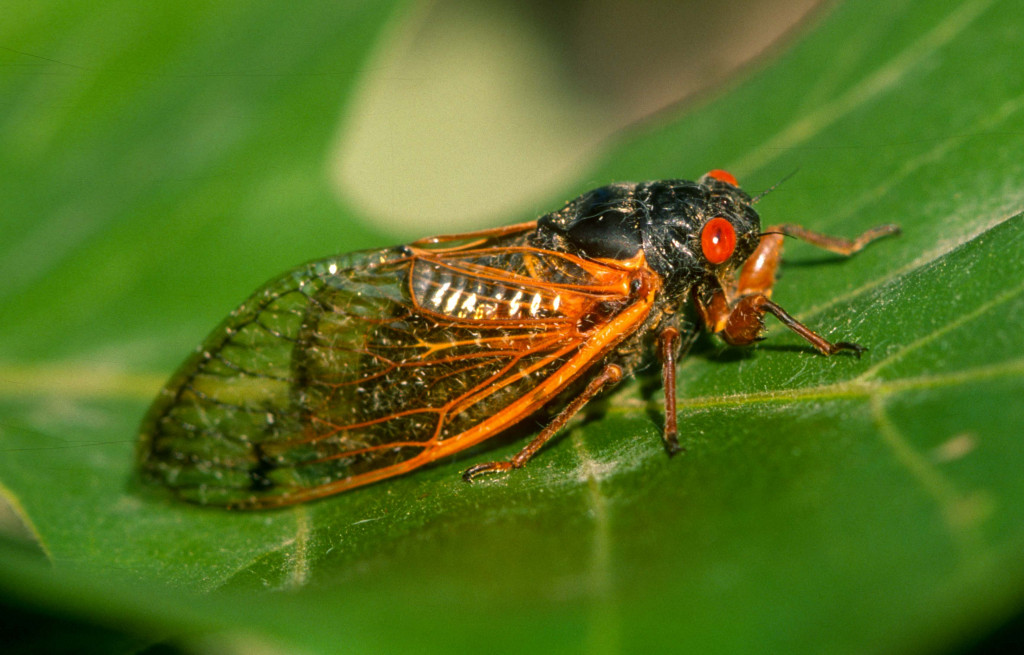An Annual Cicada
Enlarge

in Aurora. Photo by Gerry Steinauer.
Photo by Gerry Steinauer
Story and photos by Gerry Steinauer, Botanist
During the dog days of late summer, the reverberating call of the scissors grinder cicada (Neotibicen pruinosus) begins late in the afternoon and continues into dusk. Emanating from high in the trees, individual calls initiate softly and build to a loud, shrill, “WHEE-oo WHEE-oo” crescendo lasting about 20 seconds. Sometimes, it’s a lone call; other times, it’s a cacophony, an apparent horde singing in a shrieking chorus. Some find the call a beautiful sound of nature, a fond tradition of summer; others find it as annoying as the neighbor’s broken-down, muffler-less lawn mower.
Blame the male scissors grinder for making all the noise. The insect is so named because in days gone by the call reminded people of the sound of scissors being sharpened on a grinding wheel. The call is his means of wooing a female with which to mate.
The scissors grinder is the 2-inch-long, thick, green-bodied, bulging-eyed insect that you sometimes see on sidewalks or in the grass below trees. When disturbed, they often buzz their wings, spinning their bodies, before taking off in erratic, apparently drunken, flight. More commonly encountered are the telltale exoskeletons left on tree trunks and branches by scissors grinder nymphs as they molt into adults.

Nebraska Cicadas
Roughly 3,000 species of cicada are known worldwide, a staggering number that makes Nebraska’s cicada fauna, 22 species of annual cicada and 2 species of 17-year cicada (see sidebar on page 41), seem impoverished. Besides the scissors grinder, our other annual species include the southern grass cicada, bush cicada, lyric cicada and plains dog-day cicada. Some are woodland species, while others are grassland species. They range from common and fairly widely-distributed to rare with a limited range in our state.
The scissors grinder is our most common annual cicada, inhabiting rural and urban deciduous woodlands throughout much of eastern Nebraska and extending westward along wooded river valleys. The Walker’s cicada is another common annual cicada sharing roughly the same range and habitat with the scissors grinder. Although nearly identical in appearance, the species are easily distinguished by their calls. The Walker’s call is louder: a pulsing, droning “jeeb-jeeb-jeeb-jeeb” rasp. An internet search will provide recordings of the calls of these species and others.
The Life Cycle
Like all annual cicada, a scissors grinder’s life begins when a nymph emerges from an egg, which in this case, was laid in a tree. The tiny hatchling drops from the tree and burrows into the ground in search of a tree root from which it will suck sap. The nymph lives underground for three to five years, molting several times before digging its way out of the soil, leaving a half-inch exit hole near a tree. Unlike 17-year cicada, annual cicada emergence is not synchronized; some individuals emerge each summer.

The nymph’s journey continues as its climbs a tree, eventually halting and tightly clinging to the trunk or branch to undergo its final transformation into an adult. First, the cicada pushes its head and thorax through the back of the exoskeleton of the nymph. Then the legs emerge and grab the head of the exoskeleton and pull out the rest of the body. The adult, still clinging to the exoskeleton, now slowly and gently unfolds its wings. Once unfurled, the wings and body begin to harden and change color, at one point turning a beautiful hue of gold, and voilà, the adult scissors grinder is ready to rock-n-roll.
Living only four to five weeks, the adults waste no time in their rush to reproduce. The males climb high into a tree and begin calling by expanding and contracting an organ on their abdomen. The females, which emerge a few days after the males, respond by clicking their wings at a slow, steady pace, making a sound resembling snapping fingers that attracts males. After mating, females seek a small branch and, using their mouthparts — small, sharp, straw-like structures tucked beneath their head — make several slits in the bark, in which they lay 20 to 40 eggs. They repeat this process several times, laying a total of 200 to 400 eggs with the goal of starting a new generation of treetop singers.
Hopefully, their chorus tugs at your heart strings rather than rattling your brain.
17-year Cicadas
The Cassin’s cicada and the pharaoh cicada, the latter also known as the Linnaeus’s cicada, are our state’s only species of 17-year cicada. Inhabiting deciduous woodlands in southeastern Nebraska, they are easily distinguished from annual cicadas by their black bodies, orange legs and wing veins and beautiful reddish-orange eyes. The pharaoh is distinguished from Cassin’s by the broad orange stripe on its abdomen.

The life cycle of a 17-year cicada is similar to that of an annual cicada, except that the nymphs feed and molt in the soil for 17 years and all individuals emerge during the same year. The synchronized emergence, which starts in early June in Nebraska, may be a strategy to overwhelm predators, mainly birds. Strangely, both the pharaoh and Cassin’s cicada are on the same 17-year cycle, emerging the same year. They last appeared in Nebraska in 2015.
The pharaoh’s call is a high-pitched “weeeee-whoa” or “pharaoh,” while the Cassin’s call is a series of ticks followed by a drawn-out buzz, which rises and falls in pitch. Both calls last only a few seconds. In prime habitat, the in-unison calling of tens of thousands of 17-year cicadas is a raucous event of biblical proportions. Prepare yourselves: They will come again in 2032.
The post The Scissors Grinder appeared first on Nebraskaland Magazine.
















